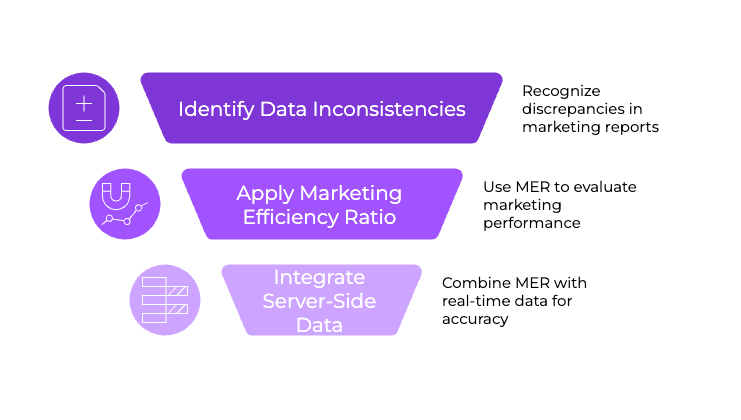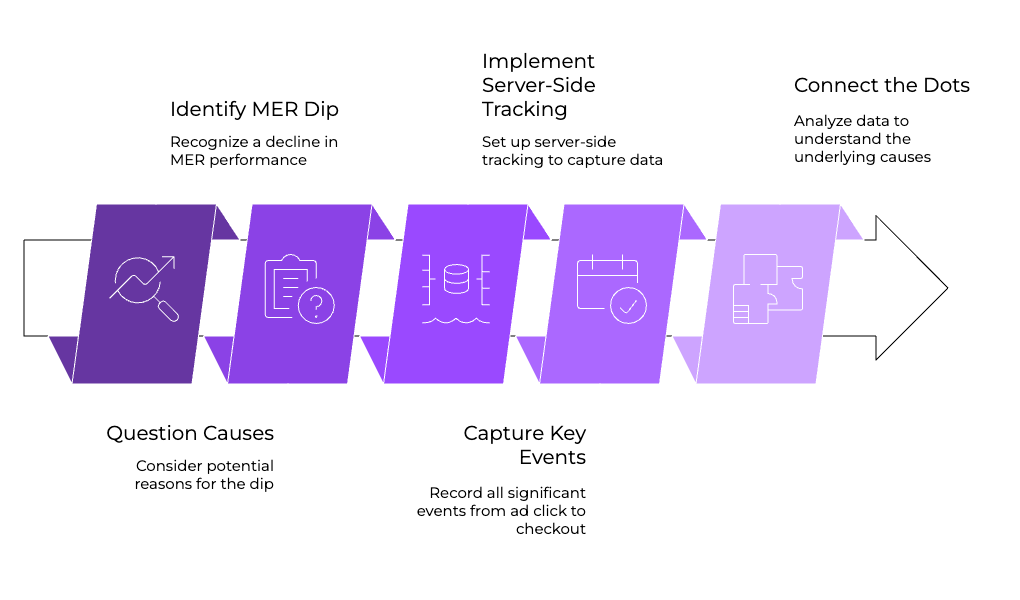Marketing Efficiency Ratio (MER): The One Metric Smart Brands Won’t Ignore in 2025

You’ve got privacy restrictions breaking your pixels, platforms over-reporting what they “think” they delivered, and about twelve different dashboards telling you twelve different stories. It’s no wonder CMOs are waking up in cold sweats over budget calls.
But here’s a stat you can actually trust: Marketing Efficiency Ratio (MER).
And no, it’s not another acronym invented by consultants. It’s the most useful number in your entire marketing stack. In this post, I’ll walk you through why MER matters, how it actually works, and why combining it with real server-side data (like what we do at Trackity) is how modern Shopify and WooCommerce brands stay ahead.
What is MER and Why Should You Care?
Put simply, MER is:

MER = Marketing Spend/Total Revenue
It’s brutally honest.
Unlike ROAS, which gets tangled in channel-level fluff, MER zooms out and says: “Hey, for every dollar you spent on marketing, here’s how many dollars came back through the register.”
If you made $100k and spent $20k to get it, your MER is 5.0. Clean, direct, and no cookies required.
ROAS Lies. MER Doesn’t.

Every ad platform will show you ROAS like it’s gospel. But the reality?
- Facebook takes credit.
- Google takes credit.
- TikTok takes credit.
For the same sale.
So when your platform dashboards say “ROAS 4.1,” it’s often inflated sometimes by 50% or more. That’s where MER steps in. It shows you the full picture, across all spend, all channels.
No duplicate credit. No guesswork. Just actual efficiency.
But MER Has Limits: Unless You Track It Right

Okay, so MER gives you the big picture. But what if you want to know why it’s dipping this month?
- Was it a bad campaign?
- A sudden drop in AOV?
- Or maybe checkout tracking broke on Safari… again?
That’s where Trackity comes in. We don’t just calculate MER, we connect the dots under the hood. Using server-side tracking, we capture every key event from ad click to checkout success without relying on fragile pixels or scripts.
How Trackity Makes MER Actually Useful

Here’s what we’ve built (and why it matters):
1. Revenue You Can Actually Trust
No more missing conversions from Apple users. No more inflated Meta reports. Our server events confirm what really happened and sync it directly with your ad platforms.
2. Shopify + WooCommerce Integration
We pull revenue straight from your store, not just your analytics. That means your MER isn’t based on clicks. It’s based on cash collected.
3. Real-Time Dashboard
Track your MER hourly. See spikes. Spot waste. Make budget calls with clarity, not on hope.
4. Campaign-Level Efficiency
Want to see how MER breaks down by campaign, SKU, or customer cohort? Easy. Our system tags and pipes everything cleanly so you don’t need a PhD to spot what’s working.
What’s a Good MER in 2025?
This depends on your margin structure and business model, but here’s what we’re seeing:
| Industry Type | Strong MER |
|---|---|
| DTC (Shopify) | 4.0 – 6.0 |
| SaaS | 5.0 – 9.0 |
| Subscription | 3.0 – 5.0 |
If you’re seeing MER under 2.5 for more than two months in a row? Something’s off, and it’s probably not just your ads.
What’s Killing Your MER (and How We Fix It)
Here’s what’s driving down efficiency for most brands we talk to:
🛑 Platform Overlap: Google and Meta both claim credit for the same conversion
🛑 Cookie Loss: Safari, Firefox, iOS block critical data
🛑 Laggy Attribution: Standard tags miss fast checkouts or return buyers
🛑 Tool Overload: Data is split across 5 platforms and no one has the full picture
Trackity solves this by replacing browser-dependent tracking with our own event stream, hosted server-side, and verified in real time. We even enrich conversion data with product details, cart value, and customer metadata to improve reporting fidelity.
A Real Story: From Guesswork to Clarity
A Shopify Plus brand came to us with great-looking ROAS, but their profit was tanking.
Why?
Meta and TikTok were each reporting 4+ ROAS, but their MER was sitting at 1.7. Their ad spend had scaled, but conversions hadn’t.
We helped them:
- Switch to server-side tracking
- Clean up their UTMs
- Sync actual Shopify revenue to ad platforms
30 days later? Their MER jumped to 4.3.
And bonus: their media buyer stopped pulling their hair out every Monday.
MER Is Simple. But It’s Not Easy.

The number is easy. Getting it to tell the truth is the hard part.
That’s why we built Trackity, to give modern marketers a better view of the whole funnel, not just vanity metrics.
If you’re a Shopify or WooCommerce brand tired of guessing where your dollars go, MER is your compass and we help you keep it pointing true north.
Want to See Your Real MER?
If you’re spending more than $10k/month on ads and flying blind, it’s time for clarity.
👉 Get a free demo of Trackity
No strings. Just transparency.

